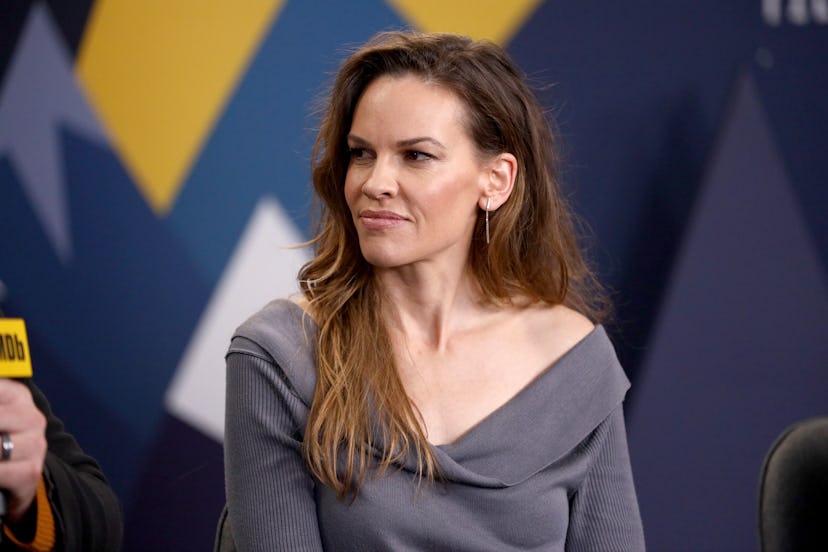Hilary Swank Admits a Trans Actor Should Have Played Her Role in Boys Don’t Cry
Hilary Swank, who played a transgender man in the 1999 film Boys Don’t Cry, says that the role would probably not go to a cisgender actor today.

Hilary Swank‘s first Oscar was awarded to her for her performance in the 1999 film Boys Don’t Cry, in which she played Brandon Teena, a trans man from Nebraska who was eventually raped and murdered in 1993.
When Swank accepted the award, she said, “We have come a long way.” She also thanked Teena in the speech. “His legacy lives on through our movie, to remind us to always be ourselves, to follow our hearts, to not conform. I pray for the day where we not only accept our differences, but we actually celebrate our diversity,” she said. The word “trans” was not mentioned at all, but at the time, Boys Don’t Cry was one of the first films with a humanizing portrait of a trans person to puncture the mainstream.
Today, though, Swank speaks very candidly about being cast as a trans man over two decades ago. “I mean, trans people weren’t really walking around in the world saying, ‘Hey, I’m trans,’” Swank recently told Variety. “Twenty one years later, not only are trans people having their lives and living, thankfully, [although] we still have a long way to go in their safety and and their inclusivity, but we now have a bunch of trans actors who would obviously be a lot more right for the role and have the opportunity to actually audition for the role.”
This is a topic that is explored in the recent Netflix documentary Disclosure, which unpacks a century of trans representation on screen, most of which has been reduced to harmful stereotypes with real-life consequences. In the film, actress and writer Jen Richards succinctly explains why cis men playing trans women directly links to the violence against trans women. This year alone, at least 30 transgender or gender non-conforming people have been killed by violent means.
“In my mind, part of the reason that men end up killing trans women out of fear of that other men will think that they’re gay for having been with trans women is that their friends, the men whose judgment they fear, only know trans women from media, and the people who play trans women are the men that they know,” Richards says in the documentary.
Richards uses the example of Eddie Redmayne—whom she also credits for “giving a really great performance as a trans woman” in The Danish Girl—to explain why having a cis actor playing a trans role perpetuates the idea that trans people are just wearing a costume, or that trans women are simply “men in disguise.” She also uses the example of Jared Leto, who won an Oscar for his portrayal of a trans woman in Dallas Buyer’s Club, but accepted the award in a suit, which reminds everyone that he is a cis man who put on a costume to play a woman.
Richards also points out that while Redmayne is able to “manifest those feminist parts of himself into a convincing trans performance” as Lili Elbe, a real-life painter who was one of the first to undergo sex reassignment surgery, the consequence is that the real person (Elbe) becomes reduced to a “performance of transness” instead of a multifaceted individual.
Redmayne is a tricky example. This year, he publicly condemned J.K. Rowling for her comments about trans people, but two months later denounced the “vitriol” thrown at her on social media for doubling down on her transphobic statements. He’s said that the opportunity to play Lili Elbe was “a great privilege,” but he’s never really done much to outright condemn the idea of a cis actor playing a trans role, and why that could be perpetuating violence against trans women in the real world.
And then there are actors like Scarlett Johansson, whose glib “apology” for accepting the part of a trans man in an upcoming biopic was hardly an apology at all, or Halle Berry, who recently announced she would play a trans role, and then, in fairness, after some “critical conversation,” stepped back from playing the part. Taking all of this into account, it does make Swank’s statements—regarding the production of Boy’s Don’t Cry and the suggestion that if it were made today, a trans actor should and probably could more likely be the one to take on the role of Brandon Teena—stand out from those of her Hollywood peers.
In the late 1990s and early 2000s, there were trans actors. Swank might be right to say that not as many of them were out back then, but the studios and the executives who make the choices to cast cis people in trans roles are certainly at fault for being the types of gatekeepers that prevented trans actors from even having the opportunity to audition for the role of a trans character, let alone be cast in the final project (which is also why Swank praises the Academy’s new diversity and inclusion guidelines). To say the least, it is a shame that it can be difficult to call to mind hardly any cis actor who has played a trans role and fully acknowledged the gravity that their casting could have on someone’s real life.
Related: Hilary Swank and Philip Schneider’s Wedding in the Redwoods Was an Ode to Burning Man